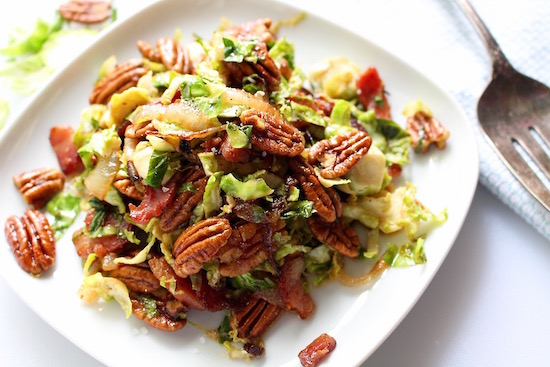I didn’t grow up eating Brussels sprouts. I guess this is a good thing because it seems many folks develop a prejudice against these adorable little cabbage buds because of bad experiences with them growing up. Usually this attitude is the result of unpleasant exposure to overcooked sprouts, which sadly, become bitter, sulfurous smelling, and overly soft. However, cooked just until tender, roasted quickly at high heat, or even eaten raw, Brussels sprouts have a way of winning over even the biggest skeptics.
Brussels sprouts are a member of the brassica family, which includes cabbages, collards, kale, broccoli, and kohlrabi. This vegetable family has a reputation for imbuing important health benefits, and Brussels sprouts are no exception. Besides being loaded with vitamins and minerals, they are also low calorie, moderately high in fiber, and are believed to help prevent cancer.
Brussels sprouts are named for Brussels, Belgium where they were popularized and may or may not have originated. The “sprouts” are edible buds that grow along thick stalks and are typically harvested once they have grown to size. The buds that grow on the bottom of the stalk are ready earlier than the buds at the top and are sometimes harvested off the stalk as they mature. Cut-off-the-stalk and fully mature is how they are often sold in supermarkets. However, if you can get sprouts still on the stalk, try them as they tend to be fresher. To harvest the buds, simply shave them off the stalk with a sharp knife
Brussels sprouts can be eaten raw or cooked. Raw, they are particularly great thinly sliced so they “shred” and then prepare like a slaw. You can shred them by first prepping the sprout. Cut a bit off of the stem end and then remove the tough and often yellowed or browned outer leaves. To “shred”, slice each sprout from to top to bottom in very thin strips. However, it is much faster to shred Brussels for a crowd by using the slicing blade of a food processor. Once shredded, sprouts can be tossed with your favorite dressing and served raw, or can be quickly sautéed and used in any number of prepared dishes.
For cooked preparations, Brussels sprouts are typically steamed, braised, blanched, roasted, or sautéed. There is some evidence that important vitamins and compounds are leached out when they are boiled. Steaming, sautéing and roasting should largely alleviate this issue. Because Brussels sprouts are tightly packed in the center, the edges cook faster than the middle when cooked whole. Thus it typically works best to halve or quarter larger prepped sprouts, trying to keep all pieces approximately the same size for even cooking. Try steaming quartered Brussels sprouts just until tender throughout, about 5 minutes. Then toss with your favorite vinaigrette or with browned butter.
Alternatively, many people, like my family, are hooked on roasted sprouts. Toss halved or quartered sprouts with a bit of oil, salt and pepper and place in a hot oven (400 degrees). Brussels cook quickly and become delectably caramelized. Roasted sprouts are very versatile and can be added to almost any dish with success. Try putting them in quiches, frittatas, grain salads, on a pizza or in a pasta dish. You can also roast Brussels with winter squash or sweet potatoes for a nice fall mix. Another fun trick is to roast individual sprout leaves until crisp, making addictive little sprout “chips”.
Dare to get creative with Brussels sprouts. Here are some flavor combinations that I find work especially well with this vegetable.
- Mustard, maple, and pork (bacon, pancetta, ham, sausage, salami, prosciutto)
- Fruit (apple, pear, raisin, grapes, pomegranate seeds, dried cranberries or cherries)
- Browned butter and Parmesan/Romano
- Asian—sweet and sour, Thai or Vietnamese flavored salad dressing, or sesame oil and rice wine vinegar
- Lemon and thyme
- Honey, sage and nuts (pecans, chestnuts, walnuts)
- Sweet potatoes or winter squash
- 2 teaspoons unsalted grass fed butter or extra virgin olive oil
- 1 large onion, quartered and thinly sliced
- 4 garlic cloves, thinly sliced
- About 1 1/2 pounds Brussels sprouts, halved and thinly sliced
- 1/2 cup vegetable or reduced sodium chicken broth
- 2 tablespoons maple syrup
- 2 teaspoons whole grain mustard
- 1/2 teaspoon salt
- 1/3 cup pecans, toasted and chopped
Brussels sprout buds should be firm, tightly packed, and vivid green. Avoid yellow, soft, wilted buds. Sprouts will keep longer if left on the stalk. Wrap in plastic as best you can and store in the refrigerator. They should last about 1-2 weeks.
*****************************************************************
Sautéed Brussels Sprouts with Maple and Pecans
Serves 8
INGREDIENTS:
In a small bowl, whisk broth, maple syrup, and mustard. Set aside. Heat butter or olive oil over medium-low heat until hot. Add onions and garlic. Cook, stirring frequently, until onions are soft and begin to brown, about 10 minutes. Add Brussels sprout leaves. Cook, stirring frequently, for 5 minutes. Add broth mixture; cook for 3-5 minutes more, stirring frequently, until liquid has almost evaporated and sprouts are crisp and tender but not overcooked. Season to taste with salt and pepper. Transfer to a serving bowl. Sprinkle with pecans and serve.
Julie Wern is a psychologist turned stay-at-home-mom turned caterer. She is currently in training at the Institute of Integrative Nutrition to become a Nutrition and Wellness coach. She is the author of Holcomb Farm CSA’s Simply Fresh blog (http://holcombfarm.org/blog)and currently teaches cooking and cookie decorating classes. Contact Julie at: jwern@comcast.net for comments and inquiries.
